

Futurism was a celebration of the machine age, glorifying war and favoring the growth of fascism. Futurist painting and sculpture were especially concerned with expressing movement and the dynamics of natural and man-made forms.
Some of these
ideas, including the use of modern materials and technique, were taken
up later by Marcel Duchamp (French, 1887-1968), the cubists,
and the constructivists.
Examples:

Giacomo Balla (Italian, 1871-1958), Street Light (Lampada — Studio di luce), 1909, oil on canvas, 68 3/4 x 45 1/4 inches (174.7 x 114.7 cm), Museum of Modern Art, NY. An extra-large image of this painting.

Giacomo Balla, Speeding Automobile (Automobile in corsa), 1912, oil on wood, 21 7/8 x 27 1/8 inches (55.6 x 68.9 cm), Museum of Modern Art, NY.

Giacomo Balla, Abstract Speed — The Car has Passed,
1913, oil on canvas,
50.2 x 65.4 cm, Tate Gallery, London.
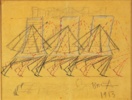
Giacomo Balla, Figure in Movement, 1913, pencil
and watercolor on paper,
22.5 x 29.5 cm, Tehran Museum of Contemporary Art, Iran.

Giacomo Balla, Swifts: Paths of Movement + Dynamic Sequences (Volo Rondini Grondaia Cielo), 1913, oil on canvas, 38 1/8 x 47 1/4 inches (96.8 x 120 cm), Museum of Modern Art, NY.

Joseph Stella (American, 1877-1946), Battle of Lights, Coney Island, c. 1913-14, oil on canvas, 39 x 29 1/2 inches, Sheldon Memorial Art Gallery and Sculpture Garden, U of Nebraska, Lincoln. One of very few American Futurists, Stella's contribution to Futurism is contained in a series of paintings celebrating the dynamism of New York's Brooklyn Bridge and Coney Island. This painting seems to be a kind of final synthesis of the series as a whole.

Joseph Stella, The Brooklyn Bridge: Variation on an Old Theme,
1939, oil on canvas,
70 x 42 inches (177.8 x 106.7 cm), Whitney Museum of American
Art, NY. Notice that Joseph Stella produced this painting more than twenty years after the Italian Futurists produced their pioneering work; and, excepting Balla, Stella was older than they were.

Carlo Carrà (Italian, 1881-1966), Funeral of the Anarchist Galli [Funeralli dell’anarchico Galli / Funérailles de l’anarchiste Galli), 1911, oil on canvas, 6 feet 6 1/4 inches x 8 feet 6 inches (198.7 x 259.1 cm), Museum of Modern Art, NY.

Carlo Carrà, Jolts of a Cab (Sobbalzi di fiacre), 1911, oil on canvas, 20 5/8 x 26 1/2 inches (52.3 x 67.1 cm), Museum of Modern Art, NY.

Umberto Boccioni (Italian, 1882-1916), The City Rises (La città che sale / La ville qui monte), 1910, oil on canvas, 6 feet 6 1/2 inches x 9 feet 10 1/2 inches (199.3 x 301 cm), Museum of Modern Art, NY. Boccioni also produced a Study for The City Rises, 1910, crayon, chalk and charcoal on paper, 23 1/8 x 34 1/8 inches (58.8 x 86.7 cm).

Umberto Boccioni, The Laugh (La risata), 1911, oil on canvas, 43 3/8 x 57 1/4 inches (199.3 x 301 cm), Museum of Modern Art, NY.

Umberto Boccioni, States of Mind I: Those Who Go (Sati d'animo: Gli Addii), 1911, oil on canvas, 27 3/4 x 37 3/8 inches (70.5 x 96.2 cm), Museum of Modern Art, NY.

Umberto Boccioni, States of Mind II: The Farewells (Sati d'animo: Quelli che vanno), 1911, oil on canvas, 27 7/8 x 37 3/4 inches (70.8 x 95.9 cm), Museum of Modern Art, NY.

Umberto Boccioni, States of Mind III: Those Who Stay (Sati d'animo: Quelli che restano), 1911, oil on canvas, 27 7/8 x 37 3/4 inches (70.8 x 95.9 cm), Museum of Modern Art, NY.

Umberto Boccioni, Development of a Bottle in Space, 1912 (cast 1931), silvered bronze, 15 x 23 3/4 x 12 7/8 inches (38.1 x 60.3 x 32.7 cm), Museum of Modern Art, NY.

Umberto Boccioni, Antigraceful, 1913, cast 1950-51, bronze, 23 x 20 1/2 x 20 inches (58.4
x 52.1 x 50.8 cm), Metropolitan Museum of Art, NY.

Umberto Boccioni, Dynamism of a Soccer Player (Dinamismo di un
footballer), 1913, oil
on canvas, 6 feet 4 inches
x 6 feet 7 inches (193.2 x 201 cm), Museum of Modern Art, New
York.

Umberto
![]()

![]() Boccioni, Unique Forms of Continuity in Space (Forme uniche
della continuità nello spazio), 1913, cast
1972, bronze, 117.5 x 87.6 x 36.8
cm, Tate Gallery, London.
Boccioni, Unique Forms of Continuity in Space (Forme uniche
della continuità nello spazio), 1913, cast
1972, bronze, 117.5 x 87.6 x 36.8
cm, Tate Gallery, London.
The Museum of Modern art, NY, has a bronze cast in 1931.
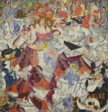
Gino Severini (Italian, 1883-1966), Dynamic Hieroglyphic of the Bal Tabarin, 1912, oil on canvas with sequins, 63 5/8 x 61 1/2 inches (161.6 x 156.2 cm), Museum of Modern Art, NY.

Gino Severini, Armored Train in Action (Train blindé en action), 1915, oil on canvas, 45 5/8 x 34 7/8 inches (115.8 x 88.5 cm), Museum of Modern Art, NY.
Gino Severini, Red Cross Train Passing a Village, summer 1915, oil on canvas, Solomon R. Guggenheim Museum, NY.

Gino Severini, Suburban Train Arriving in Paris, 1915,
oil on canvas,
88.6 x 115.6 cm, Tate Gallery, London.

Gerardo Dottori (Italian, 1884-1977), Explosion of Red on Green (Esplosione dirosso
sul verde), 1910, oil
on canvas, 49.2 x 69.5
cm, Tate Gallery, London., Tate Gallery, London.

Luigi Russolo (Italian, 1885-1947), Dynamism of an Automobile, 1912-1913,
oil on canvas,
106 x 140 cm, Georges Pompidou Center, Paris.
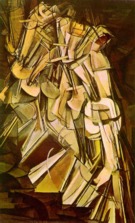
Marcel Duchamp (American, born France, 1887-1968; in U.S.A. 1915-18, 1920-23, 1942-68),
Nude
Descending a Staircase, 1911-12, oil
on canvas, 58 x 35 inches,
Philadelphia Museum of Art, PA. Sometimes called Cubo-Futurist,
so also see Cubism,
as well as the Armory Show of
1913, in which this painting was highly controversial.
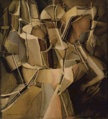
Marcel Duchamp, The Passage from Virgin to Bride (Le passage de la vierge à la mariée), July-August, 1912, oil on canvas, 23 3/8 x 21 1/4 inches (59.4 x 54 cm), Museum of Modern Art, NY.
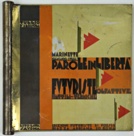
Tullio d'Albisola (Italian, 1899-1971), Parole in libertà futuriste, tattili-termiche
olfattive by Filippo Tommaso Marinetti, 1932-34, illustrated
book with 26 lithographs on metal,
edition: c. 25, page: 9
3/16 x 8 11/16 inches (23.3 x 22 cm), Museum of Modern Art, NY.
Publisher: Edizioni Futuriste di Poesia, Rome.
Also see four-dimensional,
isms and -ism, kinesiologist,
kinetic, space-time,
time, and Vorticism.
https://inform.quest/_art
Copyright © 1996-![]()